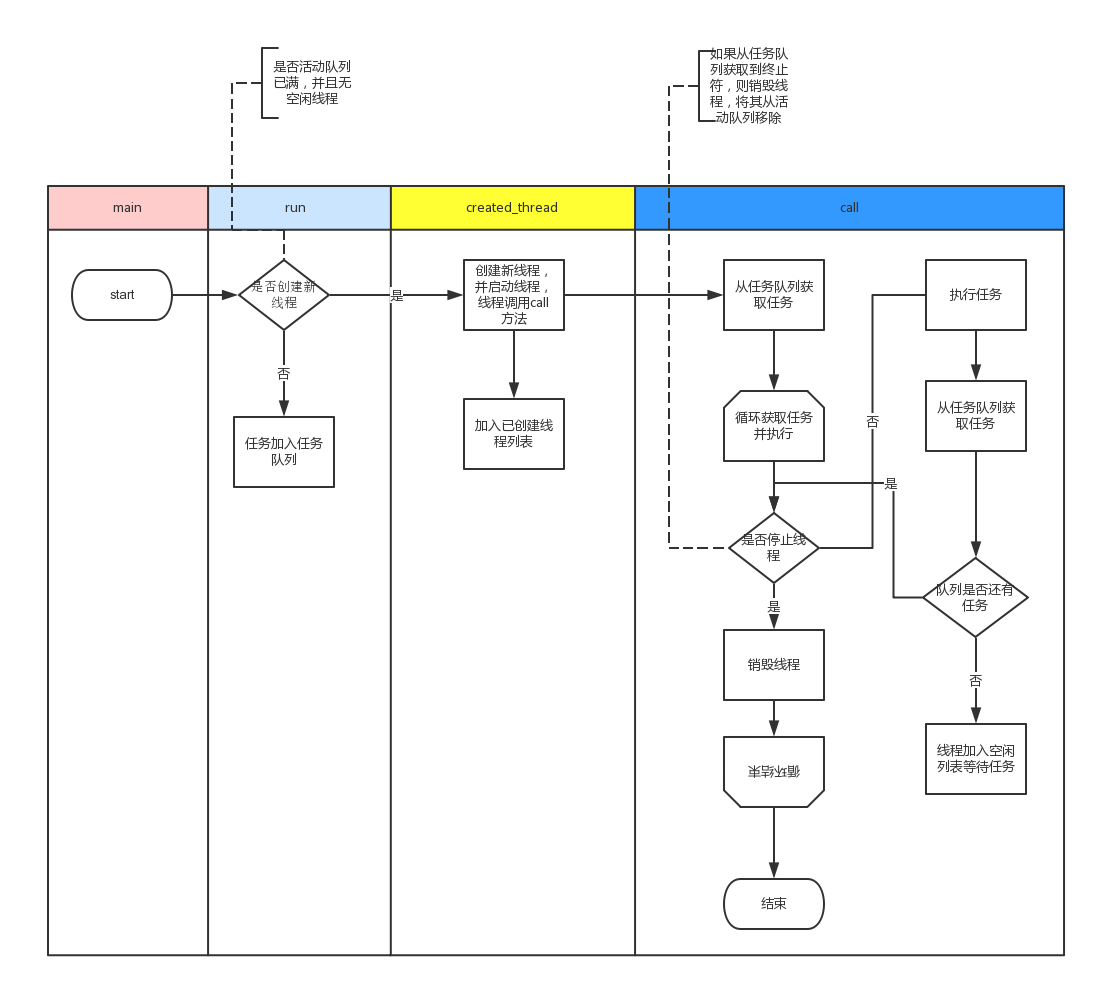关于python的多线程,由与GIL的存在被广大群主所诟病,说python的多线程不是真正的多线程。但多线程处理IO密集的任务效率还是可以杠杠的。
我实现的这个线程池其实是根据银角的思路来实现的。
主要思路:
任务获取和执行:
1、任务加入队列,等待线程来获取并执行。
2、按需生成线程,每个线程循环取任务。
线程销毁:
1、获取任务是终止符时,线程停止。
2、线程池close()时,向任务队列加入和已生成线程等量的终止符。
3、线程池terminate()时,设置线程下次任务取到为终止符。
流程概要设计:

详细代码:

import threading
import contextlib
from Queue import Queue
import time
class ThreadPool(object):
def __init__(self, max_num):
self.StopEvent = 0#线程任务终止符,当线程从队列获取到StopEvent时,代表此线程可以销毁。可设置为任意与任务有区别的值。
self.q = Queue()
self.max_num = max_num #最大线程数
self.terminal = False #是否设置线程池强制终止
self.created_list = [] #已创建线程的线程列表
self.free_list = [] #空闲线程的线程列表
self.Deamon=False #线程是否是后台线程
def run(self, func, args, callback=None):
"""
线程池执行一个任务
:param func: 任务函数
:param args: 任务函数所需参数
:param callback:
:return: 如果线程池已经终止,则返回True否则None
"""
if len(self.free_list) == 0 and len(self.created_list) < self.max_num:
self.create_thread()
task = (func, args, callback,)
self.q.put(task)
def create_thread(self):
"""
创建一个线程
"""
t = threading.Thread(target=self.call)
t.setDaemon(self.Deamon)
t.start()
self.created_list.append(t)#将当前线程加入已创建线程列表created_list
def call(self):
"""
循环去获取任务函数并执行任务函数
"""
current_thread = threading.current_thread() #获取当前线程对象·
event = self.q.get() #从任务队列获取任务
while event != self.StopEvent: #判断获取到的任务是否是终止符
func, arguments, callback = event#从任务中获取函数名、参数、和回调函数名
try:
result = func(*arguments)
func_excute_status =True#func执行成功状态
except Exception as e:
func_excute_status = False
result =None
print '函数执行产生错误', e#打印错误信息
if func_excute_status:#func执行成功后才能执行回调函数
if callback is not None:#判断回调函数是否是空的
try:
callback(result)
except Exception as e:
print '回调函数执行产生错误', e # 打印错误信息
with self.worker_state(self.free_list,current_thread):
#执行完一次任务后,将线程加入空闲列表。然后继续去取任务,如果取到任务就将线程从空闲列表移除
if self.terminal:#判断线程池终止命令,如果需要终止,则使下次取到的任务为StopEvent。
event = self.StopEvent
else: #否则继续获取任务
event = self.q.get() # 当线程等待任务时,q.get()方法阻塞住线程,使其持续等待
else:#若线程取到的任务是终止符,就销毁线程
#将当前线程从已创建线程列表created_list移除
self.created_list.remove(current_thread)
def close(self):
"""
执行完所有的任务后,所有线程停止
"""
full_size = len(self.created_list)#按已创建的线程数量往线程队列加入终止符。
while full_size:
self.q.put(self.StopEvent)
full_size -= 1
def terminate(self):
"""
无论是否还有任务,终止线程
"""
self.terminal = True
while self.created_list:
self.q.put(self.StopEvent)
self.q.queue.clear()#清空任务队列
def join(self):
"""
阻塞线程池上下文,使所有线程执行完后才能继续
"""
for t in self.created_list:
t.join()
@contextlib.contextmanager#上下文处理器,使其可以使用with语句修饰
def worker_state(self, state_list, worker_thread):
"""
用于记录线程中正在等待的线程数
"""
state_list.append(worker_thread)
try:
yield
finally:
state_list.remove(worker_thread)
if __name__ == '__main__':
def Foo(arg):
return arg
# time.sleep(0.1)
def Bar(res):
print res
pool=ThreadPool(5)
# pool.Deamon=True#需在pool.run之前设置
for i in range(1000):
pool.run(func=Foo,args=(i,),callback=Bar)
pool.close()
pool.join()
# pool.terminate()
print "任务队列里任务数%s" %pool.q.qsize()
print "当前存活子线程数量:%d" % threading.activeCount()
print "当前线程创建列表:%s" %pool.created_list
print "当前线程创建列表:%s" %pool.free_list
import threading
import contextlib
from Queue import Queue
import time
class ThreadPool(object):
def __init__(self, max_num):
self.StopEvent = 0#线程任务终止符,当线程从队列获取到StopEvent时,代表此线程可以销毁。可设置为任意与任务有区别的值。
self.q = Queue()
self.max_num = max_num #最大线程数
self.terminal = False #是否设置线程池强制终止
self.created_list = [] #已创建线程的线程列表
self.free_list = [] #空闲线程的线程列表
self.Deamon=False #线程是否是后台线程
def run(self, func, args, callback=None):
"""
线程池执行一个任务
:param func: 任务函数
:param args: 任务函数所需参数
:param callback:
:return: 如果线程池已经终止,则返回True否则None
"""
if len(self.free_list) == 0 and len(self.created_list) < self.max_num:
self.create_thread()
task = (func, args, callback,)
self.q.put(task)
def create_thread(self):
"""
创建一个线程
"""
t = threading.Thread(target=self.call)
t.setDaemon(self.Deamon)
t.start()
self.created_list.append(t)#将当前线程加入已创建线程列表created_list
def call(self):
"""
循环去获取任务函数并执行任务函数
"""
current_thread = threading.current_thread() #获取当前线程对象·
event = self.q.get() #从任务队列获取任务
while event != self.StopEvent: #判断获取到的任务是否是终止符
func, arguments, callback = event#从任务中获取函数名、参数、和回调函数名
try:
result = func(*arguments)
func_excute_status =True#func执行成功状态
except Exception as e:
func_excute_status = False
result =None
print '函数执行产生错误', e#打印错误信息
if func_excute_status:#func执行成功后才能执行回调函数
if callback is not None:#判断回调函数是否是空的
try:
callback(result)
except Exception as e:
print '回调函数执行产生错误', e # 打印错误信息
with self.worker_state(self.free_list,current_thread):
#执行完一次任务后,将线程加入空闲列表。然后继续去取任务,如果取到任务就将线程从空闲列表移除
if self.terminal:#判断线程池终止命令,如果需要终止,则使下次取到的任务为StopEvent。
event = self.StopEvent
else: #否则继续获取任务
event = self.q.get() # 当线程等待任务时,q.get()方法阻塞住线程,使其持续等待
else:#若线程取到的任务是终止符,就销毁线程
#将当前线程从已创建线程列表created_list移除
self.created_list.remove(current_thread)
def close(self):
"""
执行完所有的任务后,所有线程停止
"""
full_size = len(self.created_list)#按已创建的线程数量往线程队列加入终止符。
while full_size:
self.q.put(self.StopEvent)
full_size -= 1
def terminate(self):
"""
无论是否还有任务,终止线程
"""
self.terminal = True
while self.created_list:
self.q.put(self.StopEvent)
self.q.queue.clear()#清空任务队列
def join(self):
"""
阻塞线程池上下文,使所有线程执行完后才能继续
"""
for t in self.created_list:
t.join()
@contextlib.contextmanager#上下文处理器,使其可以使用with语句修饰
def worker_state(self, state_list, worker_thread):
"""
用于记录线程中正在等待的线程数
"""
state_list.append(worker_thread)
try:
yield
finally:
state_list.remove(worker_thread)
if __name__ == '__main__':
def Foo(arg):
return arg
# time.sleep(0.1)
def Bar(res):
print res
pool=ThreadPool(5)
# pool.Deamon=True#需在pool.run之前设置
for i in range(1000):
pool.run(func=Foo,args=(i,),callback=Bar)
pool.close()
pool.join()
# pool.terminate()
print "任务队列里任务数%s" %pool.q.qsize()
print "当前存活子线程数量:%d" % threading.activeCount()
print "当前线程创建列表:%s" %pool.created_list
print "当前线程创建列表:%s" %pool.free_list
关于上下文处理:
来个简单例子说明:
下面的代码手动自定义了一个myopen方法,模拟我们常见的with open() as f:语句。具体的contextlib模块使用,会单独开章来将。
|
1
2
3
4
5
6
7
8
9
10
11
12
13
14
15
16
17
18
|
# coding:utf-8import contextlib@contextlib.contextmanager #定义该函数支持上下文with语句def myopen(filename,mode): f=open(filename,mode) try: yield f.readlines() #正常执行返回f.readlines() except Exception as e: print e finally: f.close() #最后在with代码快执行完毕后返回执行finally下的f.close()实现关闭文件if __name__ == '__main__': with myopen(r'c:ip1.txt','r') as f: for line in f: print line |
总结
实现这个线程池我吐血三升啊。
